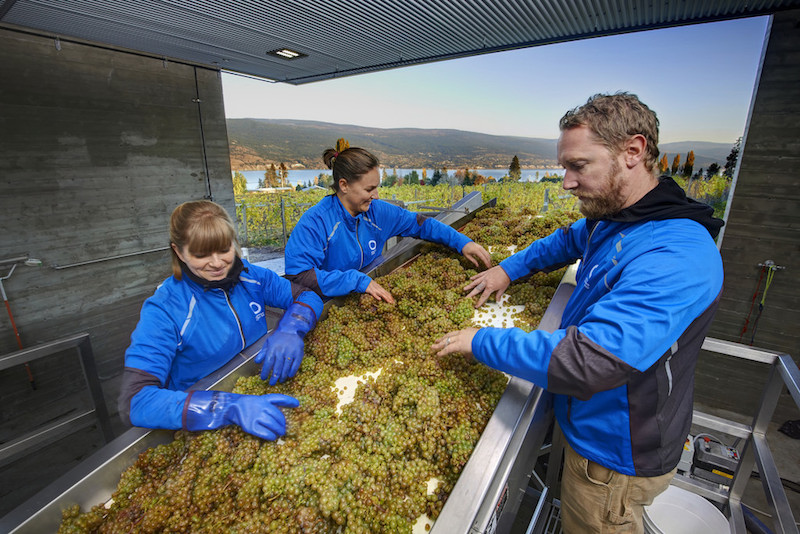
It truly has been a wonder to watch Summerland, B.C.’s Okanagan Crush Pad, which includes the Haywire, Narrative and Samantha brands (among others), transform from its early vision to what it has become today.
It is, simple put, the most progressive winery in Canada, and I am not kidding here. I cannot think of one other winery in Canada that has achieved what OCP owners Steve Lornie and Christine Coletta, below, have achieved in such a short amount of time.

Originally envisioned as co-operative, working winery for independent small-lot winemakers to produce their wines has matured into one of the most exciting self-contained wineries in B.C. dedicated to natural, organic, and pure wines using minimalist intervention in both the vineyard and winery. Nearly all the wines now are made in house under labels created by OCP.
And with the first Pinot Noir picked this fall from the winery’s Garnet Valley Ranch, a 312-acre Summerland site that has been farmed organically from the beginning, now at the crush pad, the brands can only keep growing and moving in a natural direction.
What has been remarkable is the determination to turn the OCP brands into 100% organic while using natural methods to craft the wines.


The home vineyard, Switchback, received Certified Organic Certification this summer.
When the Switchback Vineyard was converted from a fallow orchard in 2006, it was designed with local expertise and farmed conventionally. The vineyard team poured immense energy into the project and was proud of the results, which lived up to local standards. At that point, there were less than 60 hectares of organic vineyard land in B.C. and to plant an organic vineyard was not top of mind for new vineyard farmers, Lornie and Coletta.
The decision to convert to organic growing was inspired by the winery team’s work with Italian oenologist and winery consultant Alberto Antonini who pointed out what was being done globally and why organic grapes are the foundation of making wines that reflect where they are grown.
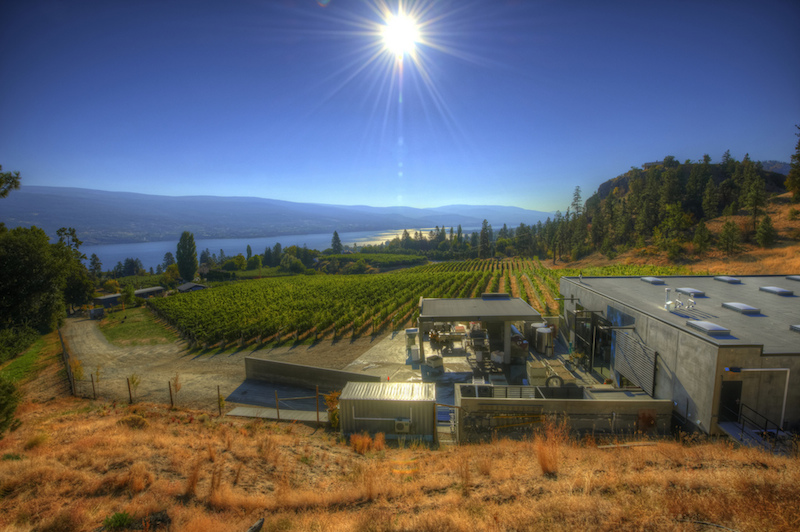
The next step for the winery team is to develop the winery’s Garnet Valley Ranch, a 312-acre Summerland site that has been farmed organically from the day it was planted. Adding to this, the contract growers the winery works with are now in transition to organic growing, setting the stage for a fully organic wine program. The winery is now on a three-year-track to use organic grapes exclusively for the production of its own wines.
“It has been an amazing amount of work,” said Coletta. “We were like parents of newborns: over-anxious, over-bearing and hovering. Perhaps we are a little more relaxed about the process now and have built up confidence in our conversion process and the outcome. That confidence has led to the next phase.”
Organic farming was just the beginning.
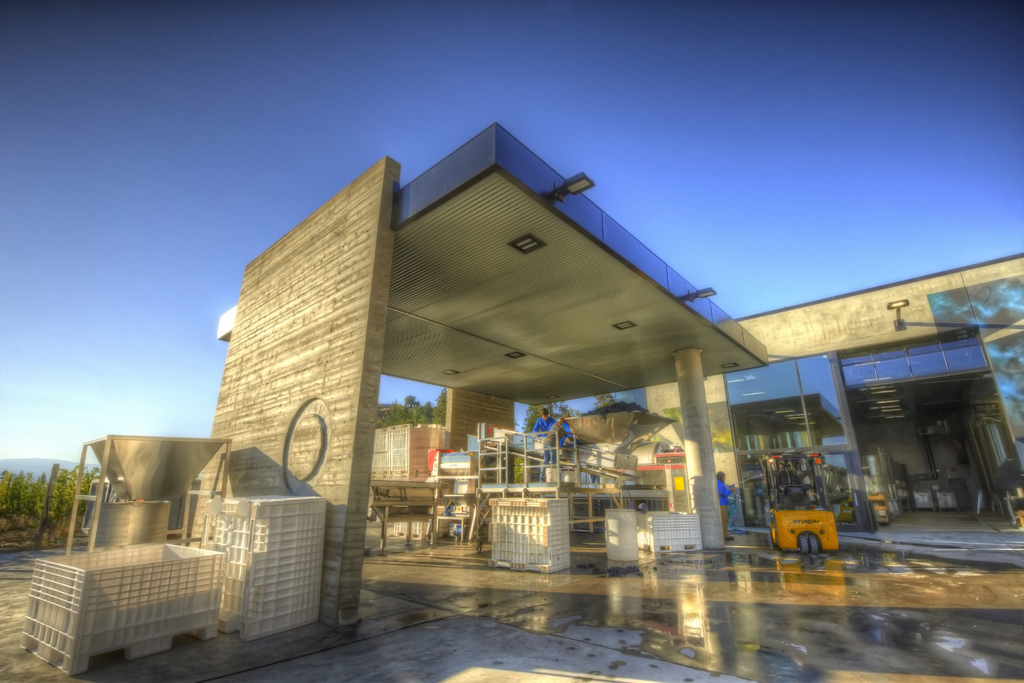
Most commercial wines are mass-made and artificially controlled at every stage of production; created from grapes that have been farmed using artificial fertilizers, herbicides, fungicides and pesticides. During the winemaking process, artificial yeasts are used, along with more than
20 permitted additives that are intended to improve body, colour, clarity and taste, while large amounts of sulphur dioxide are used as a preservative.
At OCP, use of winemaking additives is minimal and they have also eliminated what was previously used and now count on the native yeast that is naturally occurring on grape skins.

The use of oak has also been radically reduced, with any wines that are oak-aged done in old neutral barrels that do not impart flavour.
Oak barrels will be fully replaced by concrete tank fermentation and aging during the current harvest.
Sulphur dioxide is also used sparingly if at all.
Haywire wines, under the direction of winemaker Matt Dumayne, are fermented and aged exclusively in concrete and amphorae. The natural winemaking protocols for the flagship brand Haywire include:
- No commercial yeasts are used, native fermentations have 100% success.
- No additional additives including nutrients, DAP, tartaric, tannins, enzymes, ML bacteria are used.
- Minimal So2 (sulphur) is used to coincide with good vineyard practices and the use of screw cap closures.
- Processing of grapes utilizes gravity filling of tanks and pumping of must and fruit has been eliminated.
- Amphorae are filled by hand, cap wetting by hand, no punch downs.
- OCP began in 2013 making 77 cases of a skin contact – “orange wine style (called Free Form), with no so2 or filtering. Production in 2014 was 253 cases, anticipated production for 2015 is 380 cases with future continued growth.
- OCP is in the 3rd year of continuing research of native yeasts with the University of British Columbia.
- Barrel use is eliminated as of the 2014 vintage. OCP purchased an additional five concrete tanks in 2015 taking combined litreage to 65,000.
All that is well and good, but the proof is in the pudding, so to speak. And here is a look at OCP’s most recent releases, a wild and broad selection of some of the most exciting wines being made today.
Haywire The Bub 2013 ($30, 90 points) — This sparkling wine is bottle-fermented and aged using Pinot Noir and Chardonnay grown on cool vineyard sites in Oliver and Summerland. It’s finished with a nifty crown cap (which I love). It pours with a generous mousse and shows aromas of baked bread, brioche, green apple, lemon and grapefruit. It’s toasty, yet fresh, on the palate with apple, a touch of ginger, piecrust and round with citrus accents. Very nice.
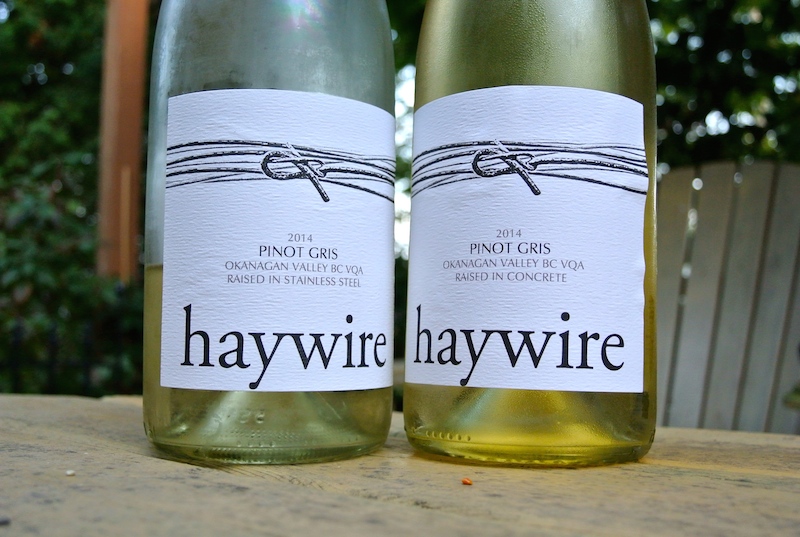
Haywire Pinot Gris “Raised in Stainless Steal” 2014 ($22, 89 points) — Haywire took the same fruit and made the two wines exactly the same with only one difference: one was fermented and aged entirely in stainless steal and the other was fermented and aged in concrete. The nose on this stainless version shows aromas of apple, tropical fruits and melon in a fresh, vibrant style. On the palate, it’s a tasty wine with a range of fresh fruits and perky, uplifting acidity.
Haywire Pinot Gris “Raised in Concrete” 2014 ($22, 90 points) — The concrete version is highly aromatic and bursting with lemon, grapefruit, green apples and a nice creamy note. I love the texture of this version and the creamy feel to the apple and citrus flavours. The fruit on the concrete version is a touch rounder and more lush.
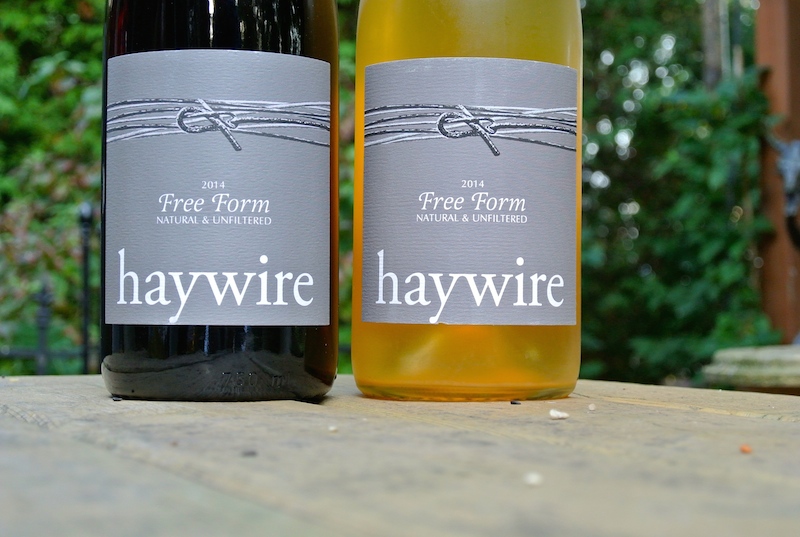
Haywire Free Form White 2014 ($35, 90 points) — OK, this is out there with some of the most creative wines being made in Canada right now. Right off the top, it’s not for everyone, but wine geeks will be enthralled, perhaps mystified, but most of all, it will get their full attention. It is made from Sauvignon Blanc with no commercial yeasts, enzymes or sulphur added. After undergoing full malolactic fermentation and five months of skin contact, the wine was pressed. Call it an orange wine, a growing category across the wine regions in Canada. The bright orange colour and cloudy appearance is the first impression. The nose is a wild mix of tangerine, citrus rind, pulpy grapefruit, minerals and slight herbal/grassy notes. There is a complex array of fruit on the palate including dried apricot, mango, citrus rind, pinch of bitter almond and tropical fruits. It is made perfectly dry with noticeable tannins and structure. As mentioned, not for all, but for those who dare take a walk on the wild side, this is for you.
Haywire Free Form Red 2014 ($55, 92 points) — The Red Free Form is another natural wine made with no intervention in the cellar. It’s made from clone 667 Pinot Noir grown on the Waters & Banks Vineyard and was fermented using wild yeast in amphora where it aged on the skins for eight months. No sulphur was added. It has a pure and attractive nose of extracted cherry, raspberry and black currants. It is a beautiful wine on the palate with a rich broth of red fruits, crushed currants, raspberry, bramble and lovely silky tannins. Winemaker Matt Dumayne nailed this one. A brilliant and natural wine.
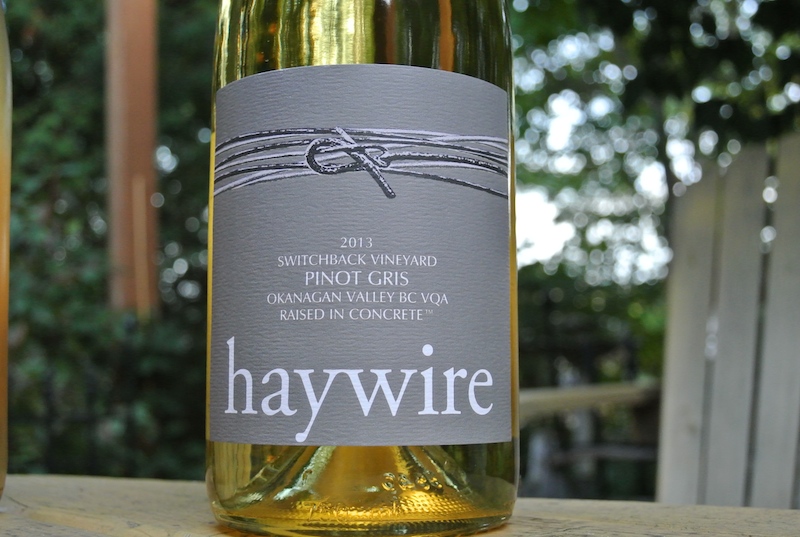
Haywire Switchback Vineyard “Raised in Concrete” Pinot Gris 2013 ($25, 90 points) — From the home vineyard, this Gris is wild fermented in concrete tanks. The nose shows apple, citrus, minerals and sharp lemon notes. It has a lovely creamy texture on the palate with apple, melon and citrus with a vibrant, crisp finish.
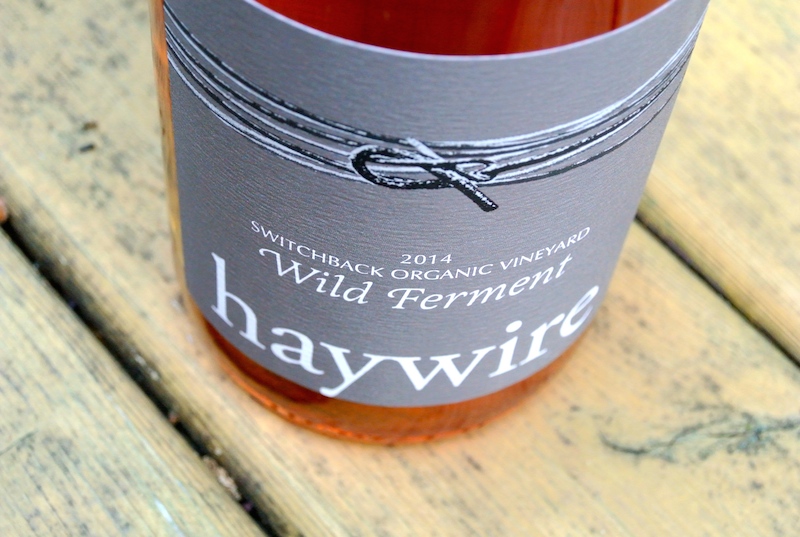
Haywire Switchback Organic Vineyard Wild Ferment 2014 ($30, 92 points) — The wine is made with 100% certified organic Pinot Gris (though Pinot Gris is not part of the label information), clone 52. The grapes are pressed and put into an 800-litre amphora to ferment on native yeast with no winemaking intervention. The wine is left on the skins for eight months, pressed and then left to rest for an additional two months before being filtered and bottled with no sulphur or other additives. The nose is unbelievable with apricot, peach compote, subtle raspberry, thyme and fragrant cranberry and apple. It has noticeable tannins on the palate and feels like a red wine with cran-cherry, pomegranate, peach, wonderful texture and a subtle earthy feel through the finish. Such a treat of wine.
Narrative White 2014 ($19, 88 points) — Made under the Okanagan Crush Pad label, this white is a blend of Chardonnay, Sauvignon Blanc, Pinot Gris and Gewurztraminer. The nose shows lychee, grapefruit, tropical fruits and white peach. It’s a tasty blend with a wide-range of fruit flavours and a touch of nutmeg and cloves.
Narrative Red 2014 ($20, 89 points) — The red version of Narrative is a blend of Gamay and Syrah with a smoky nose of red fruits, spice, earth and white pepper. It’s well poised on the palate with rich red fruits, spice, pepper and energizing acidity.
Narrative Fortified Small Batch ($45, 92 points) — This is the first fortified wine made at the Okanagan Crush Pad. It’s made with a combination of Merlot and Syrah that was fermented in concrete and fortified with grape spirits distilled on site and aged for two years in neutral oak. It clocks in at 20% alcohol and is bottled with a glass stopper, wrapped in a wax seal. The nose shows rich blueberry and kirsch with smoky/spicy/fortified notes and added cassis and pepper. It’s thick with mouth-watering currants, raspberry and blueberry with a creamy and silky texture. It finishes with a touch of chocolate/mocha.
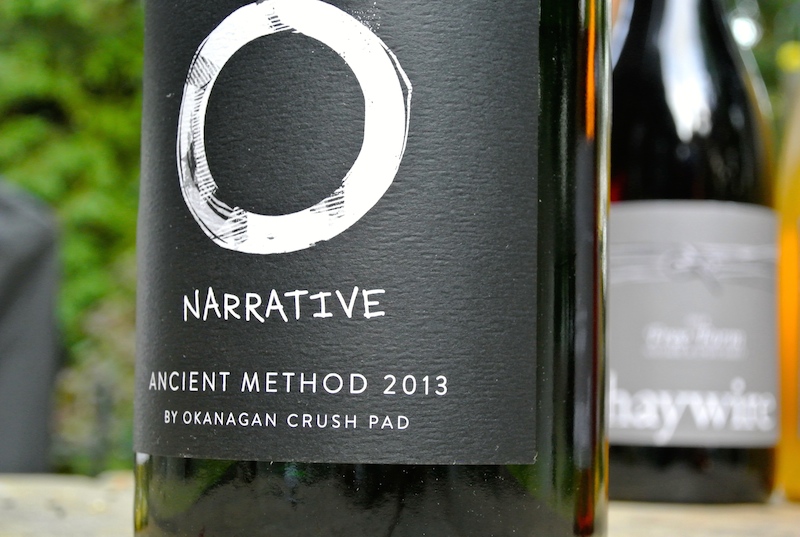
Narrative Ancient Method 2013 ($40, 90 points) — This pétillant-naturel (pét-nat) style of sparkling wine was bottled during fermentation without filtering, fining and stabilizing to show the more delicate and interesting characters unique to the 2013 vintage. It is made with 100% Chardonnay and each bottle will display different nuances depending on when it is opened. My bottle was gorgeous, even though it travelled from the Okanagan Valley to my home in St Catharines. The nose shows lemony biscuit, racy grapefruit and cream. It has a gentle mousse followed by a vibrant core of citrus, melba toast and vanilla cream.
Samantha Gamay Noir 2014 ($25, 91 points) — Made by Samantha Rahn at the Okanagan Crush Pad under the guidance of winemaker Matt Dumayne, this is one great Gamay. The nose shows mulled plums, dark cherry-berry, a touch of blueberry and savoury spices. This highly gulpable Gamay shows a range of currants, plums, black cherry and blueberry with length through the finish. Great job.






Comment here